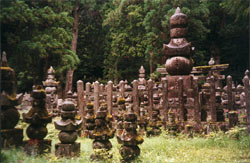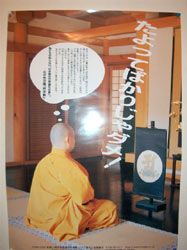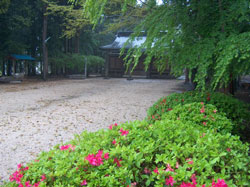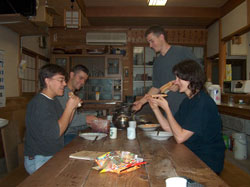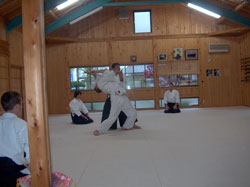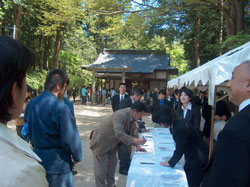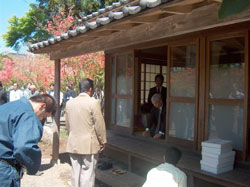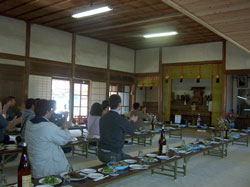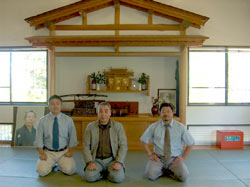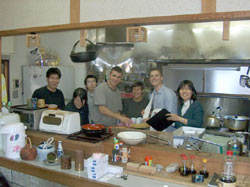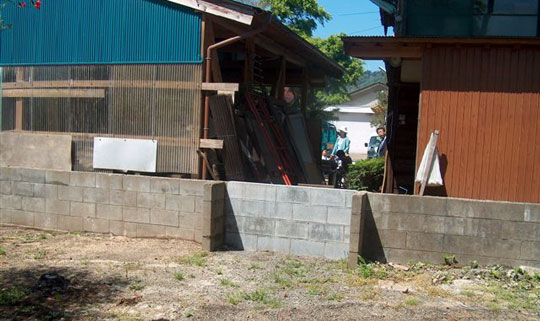
The pathway between the Saito family home and Iwama dojo blocked shut. I wonder how many people have walked on this path, even the Founder and his wife walked there daily.
It is not by accident that this article is linked from the Aiki Shrine Yearly Festival (Aiki Jinja Tai Sai) report. Some of the observations and insights in this article feel a little bitter on reflection, which I wanted to balance with experiences I have had in Japan which reveal some of the magic that is true to the true Japanese spirit. I will start my tale with these…
I have a file in my office filled to the brim with scraps of papers and ideas on subjects that I always thought someday I would write about. If I discovered something extraordinary, or even very ordinary, I would write it down and file it away in this special file. The following stories came from this file, and have been waiting for the right time to be brought to life.
I have been living now in the United States for almost 30 years. For Japanese people like me who have lived a long time away from Japan, when I go back, things stand out as striking or unusual that people living in Japan take for granted as ordinary. I think that probably Japanese people who read this article might not understand the importance of some of the simple yet profound experiences I have had at Mt. Koya, the Aiki Jinja Tai Sai and Hitohiro’s memorial remembrance for his father. For me they are valuable lessons about life and living, and I would like to share them with you.
It is written, “If you open your heart and mind fully to a thought or idea, your actions will naturally follow”. Action comes from belief in one’s self, and it takes a strong spirit to see our actions through to our goals. Knowing you have done your best at the end of every day is part of knowing yourself and is an important part of all of your actions. Being cheered on by others is meaningless if you do not motivate yourself. Listening to your own heart and walking your own path takes a strong yuuki or spirit. Listening to those who seek to turn you from your path can be a pitfall. Those who speak negatively about the path of others usually do so with words based in their own inabilities to walk their own way. There is greatness in any person who can follow their own heart and mind and not rely on or be deterred by the opinion of others.
There are some points in these stories are common knowledge for Japanese readers, but since this article has been translated into many languages, I have included facts that might be important to readers from other lands.
Stories of Mt. Koya.
High on top of Mt. Koya the Shingonshu Sohonzan Kongou Buji was built over 1,200 years ago. Center to this vast complex of temples is the Kongou Buji Temple, headquarters of the Shingon style of Buddhism. Mt. Koya rises from the seashore near Tanabe City, the birthplace of the Founder of Aikido, Morihei Ueshiba. The temple which houses the burial site of the Founder in Tanabe City belongs to the Shingon Sect. When I visit Japan, if there is any extra time, I try to visit Mt. Koya, for it is a very special place. On this trip to Iwama to attend Tai Sai and Morihiro Saito Shihan’s memorial remembrance, I made sure I had the time to make the journey to Mt. Koya.
- Centuries old burial grounds at Mt. Koya.
- Centuries old burial grounds at Mt. Koya.
After arriving at Mt. Koya, we stopped at the Kongou Buji Temple to pray. After leaving the gates of this massive temple we began wandering through the crowded streets below. I had already walked about 200 meters when I heard someone calling me from behind. First faintly, then louder I heard someone calling “Homma-san, Homma-san”. After looking about, I pointed to my nose with a gesture “Me? I am Mr. Homma!”
As a visitor from so far away as the United States to this holy place, I thought that if someone was calling my name, they must be a devil! Deciding this was nonsense, I started to retrace my steps in my mind. Did I leave something at the temple? Did I forget to pay my admission fees? Did I forget to leave a donation? The answer was no to all of these questions, so who could be calling my name? Finally, a man about my age wearing a samui (keiko-gi type uniform for temple staff) came to my side, obviously out of breath. When he finally caught up with me, I recognized him as a priest I had met at the temple. I looked down at the carefully wrapped poster tube in my hand. The poster was of a priest in meditation and was a campaign poster for the Shingon Kongou Buji Temple headquarters. The slogan on the poster said “Taiyotte Bakarija Dame!” which loosely translates as “Don’t look to the gods to give you the answers, you must find the answers in yourself!”.
There are many posters of Mt. Koya, but I had really wanted one of these, as it is indicative of some of Nippon Kan’s philosophies. After I had finished my visit to the temple, I had stopped by the administration office and asked the priest working as the receptionist if there was a place I could buy that particular poster. The young priest excused himself and went to ask his superior. The supervisor came forward with a nice smile, and informed me that if I could wait a moment that someone would bring one for me. He proceeded to carefully prepare a packing tube to protect the poster for transport. After the poster was brought forward, it was carefully rolled, wrapped in protective paper and put into the cardboard tube. After all of this elaborate preparation the supervisor priest handed it to me…
It was this priest who now stood before me in the crowded streets, sweating slightly from the exertion of trying to catch up with me. His name was Mr. Kayano, and he remembered my name from a business card I had given him at the temple.
“I am so glad I caught up with you!” he said with a smile. “I had wanted to give you these”. He reached out and place in my hand five sets of onenju (Buddhist prayer beads). These were very special onenju as they had been carved from a sacred 930 year old tree found deep in the Koya Mountains. I was quite surprised that he had given me these gifts, but I was even more surprised that he had been able to find me in the crowded streets. Once you leave the Kongou Buji temple gates there is an intersection of streets, and I could have taken any one of three possible routes from there. Yet with a ten minute start, he had found me. He continued to tell me that he was very happy that I had been interested in their poster, and that I had wanted to share it with my students in the United States. What impressed me most was that he took such initiative, and expressed such a belief in his work. He showed sincere purpose, and it left a very distinct impression on me standing with him in the middle of the crowed streets of Mt. Koya.
At the Kongou Buji temple, when you pay your admission fees you receive a coupon which entitles you to complimentary tea and cookies. This refreshment is served in a large tatami covered area overlooking some of the famous gardens cared for there. It is a simple gesture, but it is a little something extra for the price of admission that is not offered in more famous temple areas such as Kyoto or Nara.
Everyone is given one of these coupons. It does not matter the station in life of the visitor, or their level of understanding of the religion practiced there; everyone is treated with the same kind heart, leaving everyone with a good feeling inside. I concluded that it was simple kindnesses and courtesies such as I had seen that day that had kept people coming to Mt. Koya for 1200 years. Not only the majesty of the mountains and the spirit in the winds of Mt. Koya, the people are part of the wonderful spirit there…
Two years ago I visited Mt. Koya during the rainy seasons of June. It was not crowded at that time, and the cable car that made its way up the side of the mountain held only two passengers that day. When we arrived at the station at the top of the mountain, it was deserted except for the station master and one lone proprietor of a small snack stand. The station was inhabited however by many dogs. As we made our way through the station we noticed the woman running the snack stand come out from behind the stand and begin tossing stones in the direction of the dogs, chasing them from the station with her broom. It was to little avail however, and the dogs returned in a matter of minutes. Thinking about my dog back in the United States, I felt sorry for these dogs being shooed from the station and approached the woman. “Is it not true, that a black dog and a white dog are sacred symbols at Mt. Koya?” I said to her with a little harshness in my tone.
“Yes this is true” she replied. “But I worry that if these dogs do not go back to the mountains they will be picked up by the dog catcher”. With that she returned to the dogs and said earnestly “Go ahead, eat these treats and go home!” scurrying them along with her broom as she spoke. She returned her attention back to me. “Yes this mountain is a holy place for dogs, but unfortunately that makes some people think they can bring their dogs here and leave them. There are too many dogs here now, and since this is a place for visitors, they have to be rounded up. I always try to tell the dogs to stay away, that hanging around the station is dangerous for them but they never listen and I have to chase them away”. As I thought about what she said, I realized I had been very mistaken in my judgment of her actions. I felt sort of like one of the dogs, and apologized quickly with MY tail between my legs before turning to leave the station…
On that trip, after leaving the Mt. Koya temple areas we made our way by local bus to the Ryujin Hotsprings. The local bus ticket system was a little antiquated, and we were not quite sure how much bus fare we owed when we reached our destination. I asked the bus driver how much change we owed, and put the money in the change receptacle. After departing the bus, we found the hot springs inn and proceeded to change for a hot bath followed by a traditional styled dinner in our tatami room. Just as we began to eat, there was a quiet knock on the door, and one of the guest attendants entered the room. Very politely she asked if we had traveled to the inn by local bus. When we replied that we had, she said that the driver of the bus was here waiting in the lobby. My reaction was a normal one I thought as I retraced my steps again in my mind. Had I forgotten something on the bus? Did I forget to pay him for the ticket fare? After deciding I had not done either of these things, I ambled down to the lobby to meet the driver. The driver of the bus we had said farewell to hours ago stood in the entree way with his hat in his hand. He began “On the bus you asked me for the correct fare. When I reached the end of the line I realized that I had overcharged you by thirty yen for each ticket which would be a total of sixty yen. (Thirty yen is about the equivalent of thirty cents US, just pennies, actually). I am very sorry”. With that he bowed deeply and held out his hand which contained the sixty yen. I stood in surprise as I realized that this man had driven back in his own car for over two hours after the end of his shift to return the sixty yen to me. I thanked him, but before I could get his name, he was gone…
Mt. Koya is home for many generations of people, and the towns and villages have fire departments, police departments, hospitals and schools like all towns do. It is not a supernatural place, and the daily lives of its residents are quite ordinary in ways, yet even as a visitor I can sense that the special spirit of these people is wrapped in the winds of Mt. Koya. This is a place where people’s beliefs are not expressed only on certain days by lighting incense and praying before wooden images. These people carry their beliefs in their hearts, and they live them every day. This realization brought me close to tears, as I stood alone in the lobby with sixty yen in my hand.
Recently Mt. Koya officials have applied for status as a World Cultural Heritage Site to preserve its historical buildings and relics. Today in Japan, people are becoming more conscious about protecting the parts of Japan that exemplify its true spirit. I found for myself, that this spirit is not only alive in the historical sites of Mt. Koya but in its people as well.
Lets go back now to the main topic of this article…
Stories of Iwama’s Aikijinja Tai Sai Festival and the Late Morihiro Saito Shihan 9th Dan’s Memorial Remembrance Ceremony.
In February 2004, I had the opportunity to attend the Founding Celebration for Hitohiro Saito Sensei’s new organization Shinshin Aiki Shuren Kai Tanren Kan. Not even three months later I find myself back in Iwama again. This article is actually part II of my recent article,”A New Leader in Iwama”, this time focusing more on the continuance of the Saito legacy. Reading the first article is highly suggested. One of the purposes of this second article is to offer a follow up to the first article for Iwama style Aikidoka around the world that may have had concerns about Hitohiro’s independence.
Many decades ago, in the town of Iwama, the Late Morihiro Saito Shihan was called “Iwama’s Mo-chan” by the local townsfolk. “Mo-chan” as he was called, was compared to Napoleon in the way that Napoleon could sleep for three hours on his horse and be ready for battle. Mo-chan could sleep just about anywhere, and it took only about a half an hour before he was ready “for battle” again! His son Hitohiro is a lot like his father in this way. I found Hitohiro the day before his father’s memorial standing in the middle of the construction site his family home had become. In the midst of a massive remodel, he was barking orders, taking measurements and overseeing the carpenter’s workmanship. Simultaneously he was meeting with dojo assistants and family members, organizing the ceremonies that would begin the following day. Somehow in all of this commotion, he found the time to arrange for tea and spend a few moments with us inquiring about our journey from the United States. He was sharp, efficient and at the same time warm and inviting. I was impressed, and saw a lot of his father in him as we sat drinking tea.
On April 26th, the private memorial ceremony for Morihiro Saito Shihan was held at Hitohiro’s new Tanren Kan dojo for family members and a few invited friends. After the ceremony, guests and family gathered for food and drink. Hitohiro placed a glass of shochu, (distilled liquor made from potatoes or grains) in front of the black framed photo of his father and raised a glass in toast “Father I know how much you loved your shochu so here is one for you too!” With that he encouraged his guest to eat and drink as he fussed over pillows for them to sit on, and worried whether the dojo was too cold with the windows open. He kept a close eye on his mother as well, making sure she was comfortable and taken care of.
As I watched him I thought, it was only a few months ago when Hitohiro surprised the Aikido world with his independence. The worry and stress that a move like that can have on a person did not show this day as he played the perfect host for his father’s remembrance, as now family householder for the Saito family.
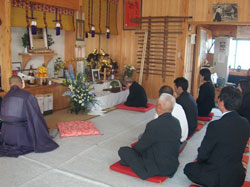
Morihiro Saito Shihan’s Memorial Ceremony for the family. In front of the altar, Saito Shihan’s widow prays.
The following morning at 6:30 am. it was time forAsageiko (morning practice). Uchideshi from many countries were joined by kayoideshi (students that do not live in the dojo, sometimes called incorrectly sotodeshi) about thirty minutes before practice to prepare the dojo for practice. When the dojo had been thoroughly cleaned they waited for Hitohiro to begin practice at 6:30 am. Sharp!
After practice, I mentioned that I wanted to go to Nikko (burial park for the popular 17th century Shogun, Tokugawa Ieyasu) to see the new colors of spring. With all that was going on, Hitohiro did not hesitate as he ordered us to hop in his car where he drove us himself to Nikko. Nikko by the way was almost a two and a half hour drive one way! I was very honored that he would spend his valuable time with us that day.
- Traditional Iwama uchideshi breakfast; toast and jam. It still makes everybody smile!
- Morning Practice. Hitohiro Sensei very kindly teaching beginners.
When the time came, Hitohiro straightened his tie and organized his students to go to the Tai Sai registration. “If we are late” he commented jokingly, “We will miss out on the lunch boxes!” Along the way he stopped to shake hands in greeting with important guests and neighbors alike. In front of Doshu’s quarters, (the former living quarters for the Founder, Morihei Ueshiba) his students lined up in straight rows, with Hitohiro before them. The otomo on duty with Doshu was a little startled by all of this, and went inside to inform Doshu of Hitohiro’s presence. In a few moments, Doshu opened the sliding doors to his quarters and came forward standing to greet the party. Hitohiro spoke formal words of “Honjitsu wa Omedeto Gozaimasu” mixed with appropriate pleasantries and a deep bow. Doshu sat down in seiza in front of him and with a big smile returned the bow. It was a beautiful scene to see. I thought that Doshu’s actions were wonderful and quite powerful and Hitohiro’s actions were pure, fresh and positive. It was a moment when it seemed that all of the layers of titles, positions, and politics were peeled away and the two men who played together as children greeted each other sincerely. It was a very natural moment and heartfelt. I remembered what I had heard from Hitohiro. “What the Saito family has received from the Ueshiba family, I will never forget”. I could see these words in this moment, in his actions, today publicly in front of everyone.In the early morning of April 29th, the Aiki Jinja Tai Sai yearly festival began its registration for the day’s events ahead. At the Saito home across the street from the Aiki Shrine, many people stopped by to pay their respects. There were many, many visitors, and Hitohiro responded to all of his guests. Sometimes he returned the wave of passers by, sometimes he moved to shake their hand or bow deeply in front of them. This depended of course if they were students of his own, students of his fathers, supporters or sponsors, neighbors or friends. I was surprised by how many visitors stopped by that day.
The question might arise for some. Why then did Hitohiro part from Aikikai? I think the answer to that question is simpler than it seems. I think that the spirit and quest for understanding the art of Aikido lies at the heart of Hitohiro’s decision. I believe that his spirit is pure and that to honor his own quest, he feels he must leave behind not only the legacy of his father, but the problems that came from his father’s time as well. I do not believe that Hitohiro has any bad feelings for Doshu. I believe his motives are pure, and the proof is in his actions. It is only with that kind of heart could he stand in front of Doshu at this Iwama Tai Sai Festival with a pure smile.
- Hitohiro Jukucho at Tai Sai guest registration.
- Hitohiro Jukucho offering his respects to Doshu.
- Praying inside the Iwama dojo, Hitohiro Jukucho and his students.
After paying his respects to Doshu, Hitohiro and his students entered the dojo to pay their respects at the shrine before returning to the Saito family home across the street. Upon his return, all of the sliding doors were opened so that the home was open to the street and the throngs of people passing by. The home celebration began with a feast of red snapper sashimi and other seasonal delights. The tables soon filled with guests who heartily joined in the festivities. Just as everyone had begun to enjoy themselves, someone spoke up “Hitohiro san, your not having anything to drink!” Everyone froze in mid-bite and turned their attention to their host. It was true. Hitohiro lifted from the floor a large bottle of grape juice that he had been drinking from. Anyone who knows Hitohiro might think that this could be a cause for worry, that maybe he was not feeling well. This could be a big issue! Hitohiro, with a bashful look on his face said “If I drink now, I cannot fulfill my duties and responsibilities as host, so for now this bottle of grape juice will do fine. But please everyone drink up! Don’t worry about me!” Even to the groups of young students seated at the far tables, he encouraged to eat their fill. He chided them however, cautioning them to drink only if they wanted to “It’s your choice”, he advised.
Hitohiro then returned to his duties as host, keeping an eye out for those who passed by the open doors. If someone raised their hand in greeting, he soon answered with a wave. If a visitor stopped by the house, he welcomed them in and found them a place to sit. Finally there was no more room at the tables, so he went to the construction site and borrowed a planning plank to build a make-shift table on top of beer crates. When still more visitors arrived, he instructed his younger students to carry trays of sake cups to offer to people as they stopped by. I commend Hitohiro for his actions. That day he was the man of the house, and his positive attitude shone brightly all through the day.
- Young and old, everyone enjoying the day.
- Yasuo Kobayashi Shihan stops by for a friendly visit.
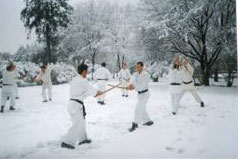 Only a few years ago, before Saito Shihan became ill, there were over thirty uchideshi students at the Iwama dojo at any given time. It was so crowded at times there was no room to walk between the sleeping mats at night. Most of theuchideshi were from countries outside of Japan. Tuition as anuchideshi was not cheap, and other living expenses in Japan were not inexpensive either. They still came though, and listened intently, even as they could not understand much of the Japanese, Saito Shihan spoke except of course his most infamous use of the word “dame!”(which means NO or bad). I think that although this was not easy training, these students learned something more than techniques from Saito Shihan. They learned something special through his special humanity and charisma. They learned something from him that has allowed them to become leaders and great instructors in their own countries upon their return.
Only a few years ago, before Saito Shihan became ill, there were over thirty uchideshi students at the Iwama dojo at any given time. It was so crowded at times there was no room to walk between the sleeping mats at night. Most of theuchideshi were from countries outside of Japan. Tuition as anuchideshi was not cheap, and other living expenses in Japan were not inexpensive either. They still came though, and listened intently, even as they could not understand much of the Japanese, Saito Shihan spoke except of course his most infamous use of the word “dame!”(which means NO or bad). I think that although this was not easy training, these students learned something more than techniques from Saito Shihan. They learned something special through his special humanity and charisma. They learned something from him that has allowed them to become leaders and great instructors in their own countries upon their return.
We must remember what lies at the heart of Iwama Aikido, and what has made it famous around the world. If we do not recognize the source and quality of the Iwama experience, it will be very difficult to sustain in the future. If we do not recognize and respect the achievements of Morihiro Saito Shihan, we will never be able to understand this legacy. If one tries to ignore or erase this power, they will change the path of Iwama history for future generations of Aikidoka to come. After the Founder’s death, there is no possible way to erase Morihiro Saito Shihan’s place in the history of Iwama, or the history of Aikido.
One of the most famous on-line and in-print publications in the Aikido world today is Aiki News(the Japanese part of Aikido Journal). For decades, Aiki News has been involved in the documentation and distribution of the life teachings of Saito Shihan, and for decades Aiki Newshas had a booth at the Iwama Tai Sai festival.
At this year’s Tai Sai festival, Aiki News was not invited, nor were they welcome to attend. In my opinion this was a grave mistake. The reason they were not invited I believe is because they have been the primary distributor for materials relating to the Saito family. It is also my opinion that it was not a good plan for the future of the now Aikikai Foundation Ibaraki Branch dojo in Iwama to alienate an organization which has such a strong influence in our Aikido community world wide. It does not make sense to me that it would be permissible at the Tai Sai festival to have booths selling Iwama-made ofuda (wooden prayer markers) or kakejiku (shrine scrolls) and other guzo(idoltry images), yet a booth offering products relating to a person that had lived his entire life in Iwama and created world-wide notoriety for the community would be excluded. I do not believe I was the only person that was thinking this during the Tai Sai festival. This decision to exclude Aiki News was a very short sighted decision based on emotions rather than on a general view of the future of Aikido in Iwama. I do not believe this decision came from Aikikai Hombu in Tokyo. I think it was the decision of a local few with private ambitions of their own.
In the recording of human history, revisionism is destructive and obviously not reflective of the truth. In our history, we have seen that those who have rewritten their own history, ignoring certain persons or events and the influence they had, ultimately succumbed to their own demise. Half-truths lead to instability in an organization and does not bid well for its future. Any one person perpetuating revisionism is not doing their organization any favors, and in the long term will cause more damage than good. Throughout history, bad advisors have lost countries for leaders who believed blindly in them, it is a lesson that we should have already learned.
The Late Morihiro Saito Shihan had a special gift and talent for not only teaching Aikido but for bringing people together under him. No other Aikido instructor in our history of Aikido has been able to reach students as Saito Shihan did. Not only with his students in Japan but with all of his students around the world did he command a degree of loyalty and respect that is well worth remembering. The videos, books, and other publications created about his life and teachings have been distributed more widely than any other instructor. If Saito Shihans’ place in history is ignored, how can Ibaraki dojo in Iwama continue its legacy into the future?
As I attended the Tai Sai Festival, I noticed superficial changes that seemed like whitewash more than substance. The path from the dojo to the Saito family home had been blocked, modern flush toilet systems had been installed, the roof and walls had been repaired, new flooring for the dojo entry way had been laid, and the forty year old Azalea trees in the garden had been moved. The new dojo organizational officers and instructors names were posted everywhere, and were announced repeatedly over huge speakers.
For me, all of these changes did not seem real. Iwama felt like it had become some kind of strange illusion or dream. With all of these changes in style and presentation, how will they be able to continue the practice of bokken and jo at the Iwama dojo? For decades any relationship between Aikido and weapons practice has not been accepted, even flatly denied at Aikikai. Will Aikikai now find approved weapons and weapon training styles to be practiced here instead? Or, will this tradition be abolished in Iwama as well.
Under the Late Saito Shihan, Iwama became a famous place world wide. Whose responsibility is it now for bringing it back to life? It will be up to the new hierarchy to answer this question, and losing the support of a media connection as large as Aiki News is a damaging start.
One instructor in this new hierarchy has spent a great deal of time teaching outside of Japan. He is famous for starting his seminars by saying “If you find that my techniques are not good, do not blame me, it is not my mistake but the mistake of the Founder”. He would never say this inside of Japan of course, but outside of the country it is part of his opening speech.
The Late Morihiro Saito Shihan began his seminars by saying “If you find that my techniques are wrong, I apologize to the Founder. I have tried my best to study and understand the Founder’s techniques the way he taught them so I could pass them along to you correctly”. It is this kind of humility that has carried his Aikido so far.
Both of these speeches have been recorded on videos that have been sold in many places around the world. I think that one of these instructors does not realize that his words have been recorded for all the world to see.
The world today is a smaller place than it was even fifty years ago. Information now travels around the globe in seconds. In Japan, students are tied tightly to organizations and kept still through loyalties and regulations. In countries outside of Japan however, students are freer to question, discuss, exchange information and decide for themselves what is right and what is not. The future of Iwama will be watched carefully, from all parts of the world.
Early on the morning of the Tai Sai Festival, a few young students stood at a distance looking wistfully at the Iwama dojo. “It really has changed hasn’t it”, I heard one of them say. “It is like my memories have been taken.” said another, while the third just stood and stared wistfully. Since it was a festival day, I tried to cheer them up with a joke. “A long time ago in Alaska “ I began, “The Russian soldiers crossed over the straights and came into Alaska to capture the towns. After they had secured the towns, all of the buildings they painted red. The Governor of Alaska woke the next morning to see that all of the buildings in his town had been painted red and soon called the President in Washington. “What should I do Mr. President?” he asked. The President answered, “As soon as the red paint dries, paint Coca Cola on top of it in white!”.
This joke got a small laugh, but the young students still looked depressed. “I can understand how you feel” I said. “You have spent much of your time and energy here. Change your thinking a little, you have white paint too you know! Believe in yourselves and your own way and keep on with your practice. The Martial Arts do not make people, people make the Martial Arts”.
Iwama students and supporters related to Iwama all over the world, I want you to know that Hitohiro Jukucho is facing his new tomorrows with great energy. He is not shrinking from the challenge of controversy, but is overcoming it with confidence and a positive energy. The pathway between the Saito family home and the old Iwama dojo may now be shut, but deep inside Hitohiro’s heart and spirit, the path remains open. No one I think can shut the pathway that lives deep within him.
Gaku Homma
Nippon Kan Kancho
May 10, 2004



